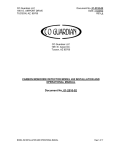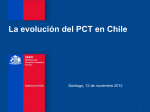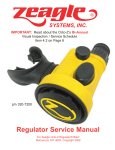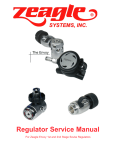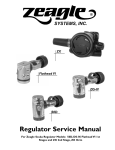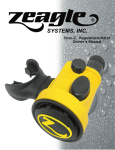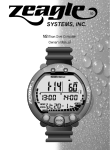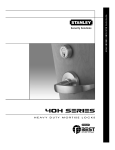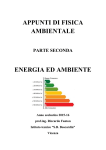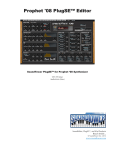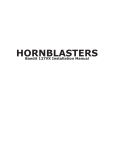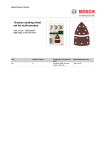Download Regulator Service Manual'99
Transcript
OCTO+ MK2 DEALERS SERVICE TECHNICIAN MANUAL Zeagle Systems, Inc. 37150 Chancey Road Zephyrhills, FL 33541 Phone (813) 782-5568 Fax (813) 782-5569 SECTION 1 PROBLEM DIAGNOSIS 1.1 PROBLEMS IN THE REGULATOR Air bubbles from the mouthpiece and/or exhalation valve (with the buoyancy device deflated). POSSIBLE CAUSES The intermediate air pressure supplied by the first stage is too high. (Max. working pressure should not exceed 160 psi.) Insufficient free movement in the lever assembly (See Fig. 1.) Valve or lever (Items 3 and 23) sticking. (Operate the lever manually several times to check smooth operation). Worn or damaged or dirty rubber valve seating (Item 9) damaged valve seat (Item 6). End cover (Item 22) distorted and presses against diaphragm causing valve to operate. Valve seat (Item 6) is not correctly located against the shoulder in the valve body (See Fig. 3). Dirty or damaged ‘O’ ring (Item 14). Additional possible causes of leakage (with the buoyancy device inflated). Damaged or dirty ‘O’ ring (Item 5). Damaged casing (Item 17) allows air to leak back from the buoyancy device. 1.2 PROBLEMS IN THE POWER INFLATOR POSSIBLE CAUSES Air bubbles from the mouthpiece when the power inflator is operated. Dirty or damaged ‘O’ ring (Item 5). Air bubbles from around the power inflator button or lock ring when operated. Lock ring (Item 28) is loose. Damaged case (Item 17). Flexible button (Item 29) is damaged or faulty. OCTO+ MK2 DEALERS SERVICE TECHNICIAN MANUAL This manual has been compiled to assist authorized service personnel to diagnose problems, make repairs and carry out the periodic service required to maintain safe and reliable functioning. This manual does not substitute for proper factory training in the service of Zeagle regulators. Before carrying out any work on the regulator you should study the notes and diagrams carefully, and ensure that a suitable clean work area and all necessary tools and parts are available. Throughout this manual the following symbol ☛ has been used to denote particularly important points, often related to safety. ☛ Most Important! You are dealing with life support equipment. A responsible attitude to all aspects of the maintenance procedure and careful handling of the product is essential to safety—both your own and your customer’s. SECTION 1 PROBLEM DIAGNOSIS SECTION 1.1 SECTION 1.2 SECTION 1.3 SECTION 1.4 PROBLEMS IN THE REGULATOR PROBLEMS IN THE POWER INFLATOR PROBLEMS IN THE ORAL INFLATOR/EXHAUST VALVE PROBLEMS IN QD COUPLING SECTION 2 DISMANTLE AND RE-ASSEMBLE SECTION 2.1 REMOVING THE POWER INFLATOR BUTTON ASSEMBLY REMOVING AND DISMANTLING THE REGULATOR VALVE ASSEMBLY RE-BUILDING THE REGULATOR ASSEMBLY RE-ASSEMBLING THE POWER INFLATOR REMOVE AND DISMANTLE THE ORAL INFLATOR/ DEFLATOR TESTING AND ADJUSTING THE REGULATOR QUICK DISCONNECT FITTING ANNUAL SERVICE REQUIREMENTS SECTION 2.2 SECTION 2.3 SECTION 2.4 SECTION 2.5 SECTION 3 SECTION 4 SECTION 5 SECTION 2 - DISMANTLE AND REASSEMBLE 2.1 REMOVING THE POWER INFLATOR BUTTON ASSEMBLY To remove the power inflator valve core (Item 31). First unscrew the lock ring (Item 28 righthand thread) and remove the flexible rubber button and button support (Items 29 and 30). Item #28 Item #29 Item #30 Unscrew the valve core using a suitable valve core key APTP29. ☛ If the rubber seal on the valve core is not removed intact on the valve core, the seal should be carefully picked out of the valve body (Item 2) and replaced with valve core. If the seal is accidentally pushed into the valve body it can usually be shaken out through the bore of the QD nipple. It is essential that the old seal is removed from the valve body. Item #31 Valve Core Seal Make sure “Rubber Seal” is not left in valve core. Item# 2 2.2 REMOVING AND DISMANTLING THE REGULATOR VALVE ASSEMBLY After removing the power inflator valve core as described in 2.1, unscrew the lock ring (Item 18) and remove the front cover and diaphragm assembly. Item #17 Item #19 Item #21 Item #20 Item #22 Item #18 Power inflator button is stiff to operate. The valve core (Item 31) is faulty. Buoyancy device inflates slowly or rapidly without operating the power inflator. The valve core (Item 31) is not securely screwed into the valve body (See Fig. 5). The valve core (Item 31) is faulty. 1.3 PROBLEMS IN THE ORAL INFLATOR/EXHAUST VALVE POSSIBLE CAUSES Air leaks from the joint between the regulator and oral inflator bodies. Dirty or damaged ‘O’ ring (Item 13). Air leaks from the oral inflator orifice. Dirty or damaged seating (Item 34). Damaged seat in body (Item 11). Air leaks from around oral inflator button. Dirty or damaged ‘O’ ring (Item 13). 1.4 PROBLEMS IN THE QD COUPLING (See Fig. 4) Coupling is difficult to or will not lock onto the connecting nipple. Coupling disconnects from nipple in use. Coupling is difficult to disconnect from nipple. POSSIBLE CAUSES Problems with the QD coupling are almost invariably due to dirt or build-up of deposits in or around the locking balls and sleeve. Thorough rinsing or soaking the coupling in warm water followed by a light application of a water displacing lubricant normally cures these problems. Coupling fails to self seal when disconnected. (See above). Dirty or damaged ‘O’ ring in coupling Coupling leaks when connected to the nipple. Damaged nipple. APSO10 Using the special wrench APS010 to prevent the valve from turning, unscrew the nyloc nut ☛ (take note of how far the nut is screwed on the valve to assist reassembly) and remove the lever and nylon anti-friction washers. Item #24 Item #25 Item #23 Item #25 The valve stem is spring loaded, so cover the QD opening and leave the ASP010 tool inserted to keep these parts from escaping. Item #5 O-Ring Item #2 Carefully remove the APS010 tool, catching the parts as they “spring” out the open end. The rubber valve seating (Item #9) can now be removed and replaced. Item #15 Item #3 Item #9 Item #6 Item #14 O-Ring 2.3 RE-BUILDING THE REGULATOR ASSEMBLY Replace the valve stem and spring in the valve body. Using the blunt end of the core key tool APTP29, compress the valve and spring sufficiently to allow the lever, anti-friction washers and nyloc nut to be replaced. ☛ Do not attempt to compress the valve and spring using the valve seat (Item 6) as this will almost certainly damage the rubber valve seating. O-Ring #5 Item #2 Item #3 APTP29 Valve Core Key Use the blunt end of tool APTP29 to compress the valve and spring into (Item #2). ☛ The valve body (Item 2) and the casing (Item 17) have corresponding location flats to prevent possible movement of the valve body in service. The ridge in the casing is not strong enough to prevent turning of the valve body when tightening the QD nipple. A special service tool APTP28 must be used otherwise damage to the casing is possible. APTP28 Item #8 Using the service tool APTP28, put into position to prevent the valve body turning, unscrew the QD nipple about 3/16". When the nipple is loose, remove the service tool and use the partially unscrewed nipple to help push the valve body out of the casing, then proceed to unscrew and remove QD nipple. Item #8 O-Ring #10 Valve Body Section 2.4 RE-ASSEMBLING THE POWER INFLATOR Item# 28 ☛ Item# 29 Item# 30 Always fit a new valve core (Item 31) if there is any doubt about the integrity of this item. Press the valve core firmly into the body while turning it to ensure that the thread engages properly, tighten securely into position. Do not over-tighten as this may cause damage to the core mechanism or seal. The shoulder of the core should be level with or just below the diameter of the valve body. 0.03” MAX Item# 31 Seal Fig. 5 Seal Replace the flexible rubber button, support and lock ring (Items 28, 29 and 30) 2.5 REMOVE AND DISMANTLE THE ORAL INFLATOR/DEFLATOR NOTE: Do not separate the regulator case (Item 17) and oral inflator body (Item 11) except to replace the ‘O’ ring (Item 13). Remove the posidrive screw behind the lever to release the oral inflator body which can now be slid off its dove tail. Item# 27 Item# 26 Item# 11 Item# 35 Removing the posidrive screw in the button will release all the remaining components. Use the fork end of the special OCTO+ wrench, APS010, to prevent the valve turning. Item# 34 Item# 13 O-Ring ☛ Item# 32 Item# 33 Item# 16 Check the condition of the rubber valve seating and seat. Assembly is in the reverse order. Do not over-tighten the posidrive screws. Remember approximately how far to screw on the nyloc nut to the stem. Using the special OCTO+ wrench to prevent the valve turning, replace the nyloc nut to approximately the same position prior to removal. IMPORTANT Ensure that the plastic friction insert in the nut is in good condition, to prevent the nut unscrewing during use. Renew the nut if any doubt. ☛ ☛ Lightly lubricate the '0' ring (Item 14) and carefully replace the valve seat (Item 6) in the body ensuring that it is pushed fully up to the shoulder (See fig. 3). Item #2 Hard up to shoulder Valve seat Item #6 Item #14 O-Ring Fig. 3 Item #6 Item #10 O-Ring Item #8 APTP28 The valve assembly can now be replaced in the case and aligned as shown to ensure "flats" on the body and in the case line up. Place tool APTP28 in proper position, then place QD nipple into place with proper torque. Item #19 Item #17 Item #21 Item #20 Item #22 Item #18 ☛ Inspect the diaphragm (Item 21) and exhaust valve (Item 20) for perforations or cracks, especially along the edge and on the "spider" where the exhaust valve attaches. Replace if any are found. ☛ Fit diaphragm (with exhaust valve installed) on case, being sure the edge of the diaphragm is in place on the case. Place end cover over diaphragm and secure with locking ring (Item 18) SECTION 4 - QUICK DISCONNECT FITTING The regulator may be fitted with one of several similar types of QD coupling. In all cases it is essential that the sleeve must slide up to the shoulder of circlip when fitted on the nipple. If the sleeve does not slide completely up to the shoulder when pushed into place, it is possible for accidental disconnection to occur. Position of Sleeve when fitted SECTION 3 - TESTING AND ADJUSTING THE REGULATOR With the end cover and diaphragm assembly removed, connect the regulator to an air supply of 125-135 psi. The objective is to minimize the free movement in the lever by adjusting the nyloc nut as shown in Fig. 1. It is important to understand that the free movement in the lever will be greater at higher pressure and less at lower pressure. The recommended adjusting pressure of 125-135 psi has been chosen to give the regulator satisfactory performance across the range of approximately 110-160 psi. Ideally the best possible performance would be achieved by adjusting the free movement while connected to the customer's own first stage, or an equivalent pres- Adjust the Nyloc Nut using a 7/32” or 5.5 MIM socket 0.25 - 0.75 MIM Free Movement at 125 - 135 PSI 8.5 - 9.5 BAR Special wrench to prevent the valve turning Fig. 1 Use the blade of the special OCTO+ wrench, APS010, inserted through the mouthpiece to prevent the valve turning, as shown in Fig. 1. Turn clockwise to relieve spring pressure, lowering the lever or counter clockwise to increase spring pressure, raising the lever. Turn the nyloc nut until you create a free flow, then turn nyloc nut back to stop the free flow. Adjust the Nyloc Nut APS010 OCTO+ MK2 PARTS LIST ITEM PART # DESCRIPTION 1 2 3 4 5 6 7 8 9 10 11 12 13 14 15 16 17 18 19 20 21 22 23 24 25 26 27 28 29 30 31 32 33 34 35 36 37 MOUTHPIECE OCTO+ MK2 VALVE BODY OCTO+ VALVE MOUTHPIECE CLIP ‘O’ RING OCTO+ MK 2 VALVE SEAT AP 1434 AP 1702 AP 1676 AP 1677 AP 1438 AP 1703 N/A AP 1710 AP 1680 AP 1445 AP 1681 AP 1709 AP 1154 AP 1409 AP 1441 AP 1589 AP 1705 AP 1683 AP 1431 AP 1429 AP 1430 AP 1684 AP 1685 AP 1686 AP 1687 AP 1693 AP 1689 AP 1706 AP 1708 AP 1707 AP 1704 AP 1571 AP 1694 AP 1691 AP 1154 AP 0157 AP 1409 OCTO+ MK 2 QUICK DISCONNECT NIPPLE OCTO+ VALVE SEATING ‘O’ RING OCTO+ ORAL INF. BODY PIN (IF FITTED) ‘O’ RING ‘O’ RING SPRING SCREW OCTO+ MK 2 REGULATOR BODY OCTO+ LOCKING RING DIAPHRAGM PAD EXHAUST VALVE DIAPHRAGM OCTO+ END COVER OCTO+ LEVER OCTO+ NYLOC NUT OCTO+ ANTI-FRICTION WASHER OCTO+ ORAL VALVE SEAT OCTO+ ORAL INFLATION VALVE BUTTON LOCK RING OCTO+ INFLATOR BUTTON BUTTON INSERT VALVE CORE SPRING OCTO+ BUTTON HEAD OCTO+ THRUST WASHER ‘O’ RING OCTO+ MK 2 HOSE ‘O’ RING SERVICE TOOLS 38 39 40 APTP28 APTP29 APS010 ALIGNING TOOL VALVE CORE KEY SPECIAL WRENCH SECTION 5 - ANNUAL SERVICE REQUIREMENTS ☛ Service the complete unit on an annual basis except for: 1. The mouthpiece (check for cracks). 2. Separation of the casing (Item 17) and oral inflation body (Item 11). The unit should be dismantled, cleaned (see note below) and examined for signs of deterioration. In particular the diaphragm and exhalation valve should be closely scrutinized. The stem of the exhaust valve where it attaches to the diaphragm should be stretched and examined for cracks or splits. If in doubt it should be replaced. 'O' ring seals (Items 5, 10, 13, 14, 35, 37), the valve seating (Item 9) and the valve core (Item 31) must be replaced. These parts are included in overhaul kit AZ002. Any other items necessary may be replaced at the technicians discretion with regard to the warranty. After cleaning and examination the regulator should be reassembled and tested according to this manual. NOTE: Never use any type of solvent to clean the rubber parts of the regulator. Parts are best cleaned by soaking in hot soapy water. A NOTE TO ALL ZEAGLE DEALERS AND SERVICE TECHNICIANS: The warranty on Zeagle products covers defects in material and workmanship only. It does not cover abuse, neglect, alterations, improper usage or normal wear. With respect to Zeagle regulators (and Octo+) Zeagle will replace defective and worn parts at no charge (excluding labor charges) that are required to maintain regulator to original manufacturers specifications as long as the regulator has been serviced within the last twelve months by an authorized Zeagle technician. Parts that are listed as "overall kit" parts will be replaced at no charge (excluding labor costs) as long as the following procedure is followed. Customer must be the original (first) owner of the item to be serviced and must be registered with Zeagle. Technician must fill out "SERVICE ORDER/PARTS REQUEST" form and customer must sign the form. Warranty items must be returned to Zeagle with the white (top) copy of form. Warranty items must be listed on the form with no charge to the customer. Replacement parts will be returned at no charge, shipping included (UPS ground) to service center. It is suggested that the service center purchase several ovehaul kits of the various regulators to be serviced so parts can be replaced at the time of servicing without delay. Dealers are not to charge customer for parts that are warranty items.













